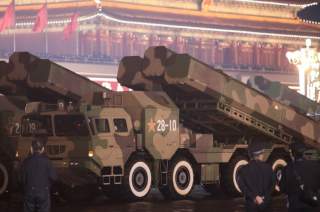Five Chinese Weapons of War India Should Fear
Should New Delhi be concerned about Beijing's growing military might?
Chengdu J-20 Fighter
China’s first fifth generation fighter, the J-20 is a large, twin-engine aircraft currently in development. The J-20’s mission set is unknown, but the aircraft’s large size supports it being either a heavy fighter or light bomber. The aircraft promises to be long-range, fast and low-observable — if not outright stealthy. The aircraft is projected to enter service with the People’s Liberation Army Air Force some time around 2020.
The J-20 is China’s most ambitious aircraft project ever. The aircraft is speculated to mount a modern AESA phased array radar and an electro-optical targeting system. The two large internal weapons bays could conceivably carry a payload of air-to-air, land attack or anti-ship missiles.
The most obvious role for the J-20 is as an air superiority fighter. The J-20’s anticipated long range means the fighter could operate over India itself if necessary. Another possible role for the J-20 would be to attack military targets within India. J-20 fighters carrying land attack missiles could precede a strike by the Second Artillery Corps, taking out Indian surface-to-air missile batteries, air bases, radar stations and command and control targets.
J-20 fighters could use PLAAF air bases in Tibet to conduct operations against India. According to the The Times of India, there are five air bases in Tibet where PLAAF Su-27UBK and Su-30MKK have practiced operations. These bases would likely be suitable for J-20 operations.
India should fear the J-20 because it represents a versatile fifth generation fighter that will be difficult to detect. The J-20 could use stealth to evade India’s air defense network and attack both air and land targets.
Kyle Mizokami is a writer based in San Francisco who has appeared in The Diplomat, Foreign Policy, War is Boring and The Daily Beast. In 2009 he cofounded the defense and security blog Japan Security Watch. You can follow him on Twitter: @KyleMizokami.

